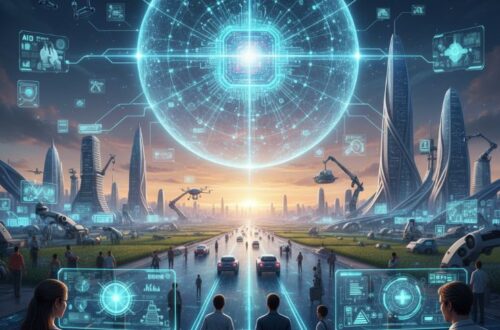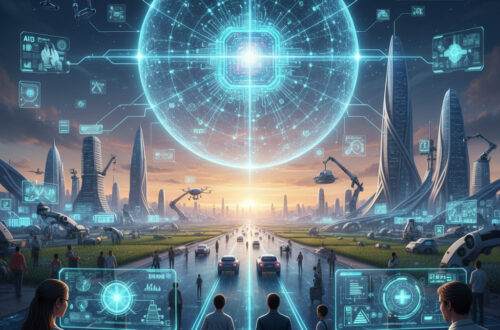From the crackle of early telephone lines to the crisp clarity of modern video conferencing, human communication has continually sought to bridge geographical distances. Platforms like Zoom, Google Meet, and Microsoft Teams became indispensable during recent global shifts, allowing us to connect faces and voices across miles. Yet, despite their convenience, these platforms inherently fall short of true human interaction. They flatten our world onto two-dimensional screens, losing the vital nuances of body language, spatial presence, and genuine eye contact. Enter Google Beam, formerly known as Project Starline, a revolutionary leap designed to transcend these limitations and usher in an era of hyper-realistic, 3D immersive communication that promises to redefine how we interact remotely.
What is Google Beam (Project Starline)?
Google Beam is a cutting-edge 3D video communication system engineered to create an incredibly realistic, hologram-like representation of another person, making it feel as if they are sitting directly across from you in the same room. It achieves this remarkable feat by integrating a sophisticated array of high-resolution cameras, depth sensors, advanced AI processing, and a unique light field display technology.
The project was initially unveiled by Google in 2021 under the name Project Starline, captivating audiences with its promise of a “magic window.” In 2024, Google rebranded the initiative as Google Beam, signaling its move towards broader commercial pilot programs and eventually, wider enterprise availability. This renaming reflects Google’s continued commitment to evolving this groundbreaking technology from a research project into a deployable solution.
How Google Beam Works
The underlying technology of Google Beam is a complex symphony of hardware and software designed to capture and render a lifelike 3D image in real time:
- 3D Capture Technology: Unlike standard webcams, Google Beam employs multiple high-resolution cameras and infrared depth sensors. These work in concert to scan the person in real time from various angles, capturing not just color but also precise three-dimensional depth information.
- Volumetric Imaging: The captured 3D data is then processed and converted into a dynamic, volumetric 3D model of the person. This model represents the individual as a complete three-dimensional object, rather than a flat image.
- Light Field Display: This is arguably the most revolutionary component. Instead of a traditional flat screen that projects a 2D image, Google Beam utilizes a light field display. This specialized screen projects different images to each of your eyes from slightly different angles, precisely recreating the way light would travel from a real object. The result is a convincing illusion of depth and presence, making the remote person appear almost like a hologram, complete with volumetric realism.
- AI Processing:Artificial Intelligence is central to every stage of Beam’s operation. AI algorithms are crucial for:
- Real-time rendering: Seamlessly transforming captured 3D data into the visual output for the light field display.
- Motion capture: Accurately tracking subtle movements and gestures.
- Facial expressions: Capturing and transmitting the nuanced details of human emotion.
- Compression for streaming: Efficiently compressing the massive amount of 3D data for low-latency transmission over networks.
A key advantage of Google Beam is that it achieves this immersive experience without the need for any special headsets or goggles for the user. The illusion of depth is created directly by the display itself.
Key Features and Innovations
Google Beam’s technological prowess translates into several groundbreaking features that redefine remote communication:
- Real Presence Effect: The most striking feature is the overwhelming sense of real presence, making it feel as though the remote individual is physically sitting across a table from you, looking directly at you.
- Low-Latency Communication: Despite the highly complex real-time rendering and data transfer, Google Beam maintains remarkably low latency, ensuring natural conversation flow without noticeable delays.
- Automatic Calibration: The system automatically calibrates itself, adjusting for individual body posture, ambient lighting, and voice characteristics to optimize the immersive experience.
- Natural Eye Contact: Through sophisticated camera arrays and light field technology, Beam achieves natural eye contact, a critical element missing from traditional video calls that often makes interactions feel disjointed.
- Spatial Audio and Facial Expression Syncing: Spatial audio makes voices sound like they are coming from the precise location of the person’s virtual presence, further enhancing realism. Simultaneously, intricate AI ensures that facial expressions and mouth movements are perfectly synced with the audio, preventing the uncanny valley effect often seen in less advanced systems.
- Remote Collaboration as Realistic as Face-to-Face: These combined features elevate remote collaboration to a level of realism previously unattainable, fostering better understanding, empathy, and engagement in virtual meetings.
Use Cases
The potential applications of Google Beam span across numerous sectors, promising to revolutionize various forms of remote interaction:
- Remote Work and Business Meetings: Transforming virtual team collaborations and executive meetings into highly immersive, personal experiences, reducing the feeling of isolation.
- Telehealth and Virtual Therapy: Enabling more empathetic and effective remote medical consultations and therapy sessions, where non-verbal cues are critical.
- Education and Training: Creating engaging virtual classrooms and training simulations where instructors and students can interact as if in the same room.
- Recruitment and Interviews: Facilitating more natural and insightful remote job interviews, allowing recruiters to better assess candidates’ personalities and communication styles.
- Medical Consultations: Particularly for specialists, offering a more nuanced way to connect with patients remotely, observing subtle physical cues.
- Global Communication without Travel: Drastically reducing the need for international business travel, with significant implications for time, cost, and environmental impact.
Benefits of Google Beam
The advantages offered by Google Beam extend beyond mere technological novelty:
- Ultra-realistic Interaction: The unparalleled realism of interaction significantly improves engagement, builds stronger rapport, and enhances empathy in remote communication.
- Reduces Business Travel: By providing a highly effective alternative to in-person meetings, Beam has the potential to significantly reduce business travel, leading to lower carbon footprints and reduced operational costs.
- Increases Efficiency in Communication: Better understanding of non-verbal cues and body language leads to clearer communication, fewer misunderstandings, and more efficient decision-making.
- Opens Up New Sectors: The immersive nature of Beam can unlock new possibilities for services that previously required physical presence, such as advanced virtual customer service or highly interactive remote education models.
Current Status and Availability (as of May 2025)
As of May 2025, Google Beam is actively being piloted in selected enterprise environments. This means that the technology is not yet publicly available for commercial purchase, but it is being rigorously tested and refined in real-world business settings.
Google has been strategically partnering with a diverse range of organizations, including large enterprises, technology companies, and academic institutions, to gather crucial feedback and optimize the system for various use cases. Reports from late 2024 and early 2025 indicate that Beam booths are being installed in select Google offices for internal testing and demonstrations, showcasing a more streamlined and potentially product-ready version of the technology. While a broad public commercial release is still anticipated, industry watchers expect broader enterprise access by late 2025 or early 2026, as Google scales production and deployment.
Limitations and Challenges
Despite its remarkable capabilities, Google Beam faces several significant limitations and challenges:
- High Cost of Hardware: The advanced cameras, intricate depth sensors, and the proprietary light-field display technology are currently very expensive, making the initial investment for a Beam setup substantial.
- Requires Ultra-Fast Internet: To transmit the massive amount of 3D volumetric data in real time with low latency, Beam necessitates an extremely stable and ultra-fast internet connection, which may not be universally available.
- Computational Complexity: The real-time AI rendering and processing required for such lifelike imagery demand immense computational power, leading to high operational costs and specialized hardware.
- Privacy and Security: The capture and transmission of highly detailed visual and depth data raise significant concerns regarding privacy and security. Ensuring that this sensitive biometric-like data is handled securely and ethically is paramount.
Competitors and Alternatives
While Google Beam pushes the boundaries of headset-free 3D communication, other companies are pursuing immersive communication through different avenues:
- Meta’s Horizon Workrooms: This platform focuses on VR-based virtual meeting spaces. While it offers a sense of shared environment, it still requires users to wear VR headsets, and the avatars are less realistic than Beam’s volumetric capture.
- Microsoft Mesh: Microsoft’s platform allows for collaborative mixed-reality experiences with holograms. Similar to Meta, it often relies on headsets (like Microsoft HoloLens) to project 3D content into the real world, and the “holograms” are not the same level of real-person volumetric capture as Beam.
- Apple Vision Pro (launched 2024): While primarily a spatial computing device, its FaceTime in 3D feature allows users to interact with others’ spatial personas. However, this still requires both parties to wear the Vision Pro headset, and the experience is within a virtual environment, not a headset-free “magic window.”
Google Beam stands out as the only major system offering a true-to-life, headset-free 3D volumetric video communication experience, setting it apart from current VR/AR-dependent alternatives.
The Future of 3D Communication
The trajectory of Google Beam and similar technologies points towards an exciting future for 3D communication:
- Integration with AI Avatars and Real-time Translation: Future iterations could seamlessly integrate realistic AI avatars for scenarios where a live presence isn’t feasible, and real-time, highly accurate translation could break down language barriers.
- Emotion Detection: Advanced AI could analyze subtle emotional cues, allowing AI to provide insights into sentiment during conversations, further enhancing communication.
- Expected Expansion: Beam’s application is expected to expand significantly in healthcare (remote diagnostics), education (immersive learning), and remote diplomacy, where nuance and presence are critical.
- Potential Integration with Premium Services: In the long term, it’s conceivable that more accessible versions of Beam technology could become a premium feature of existing communication platforms like Google Meet Premium, bringing this advanced interaction to a wider business audience.
Conclusion
Google Beam (formerly Project Starline) represents a truly groundbreaking approach to video communication. By bridging the inherent gap between physical presence and digital interaction, it offers an unprecedented level of realism and immersion. It moves beyond the limitations of flat screens, fostering genuine eye contact, spatial awareness, and a profound sense of shared space. While significant challenges related to cost, infrastructure, and privacy remain, Google’s continued investment and pilot programs signal a strong commitment to this visionary technology. The convergence of AI and immersive tech is unequivocally defining the next era of communication, promising a future where geographical distance no longer dictates the quality or depth of our human connections.





